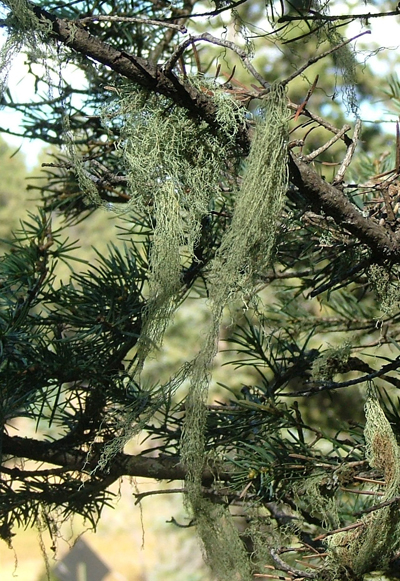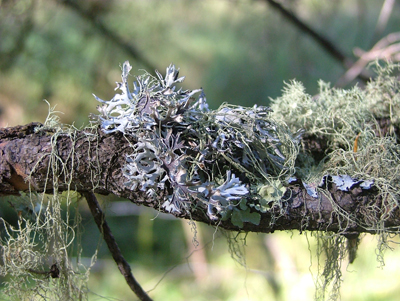Guide H-167
Stephani Sandoval
College of Agricultural, Consumer and Environmental Sciences, New Mexico State University
Author: Forest Health Specialist, Department of Extension Plant Sciences, New Mexico State University. (Print friendly PDF)
New Mexicans may notice crusty, peeling, or fibrous growth on some of their landscape trees. Usually, these are different species of lichens, non-parasitic plants that grow on the bark of various trees, especially native conifers.
What is lichen?
Lichen are not like other familiar plants in that lichen are made up of two organisms of very different types, a fungus and an alga, intimately associated with each other in a complex relationship called symbiosis. Each lichen species is one alga species plus one fungus species, each benefitting from the association. The alga makes the food for the lichen, while the fungus gives the pair support and soaks up moisture. The lichen does not have leaves, stems or roots like other plants; while it often grows on trees, it makes its own food using energy from sunlight.
What does lichen look like?
Lichens come in many forms and colors. Some are crusty structures firmly attached to the bark surface, or have leaf-like lobes extending out from the bark surface (Figure 1). Others have hair-like forms (Figure 2). Lichen colors include green, blue-green, yellow-green, brown, gray, or even red.
Figure 1. Example of leaf-like lobes on a conifer.
Figure 2. Example of hair-like form on a conifer.
Do lichens harm trees?
No. This is a common misconception. The lichen on a tree often goes unnoticed until the tree appears to be sick. However, the lichen is not the cause of the poor health of the tree. Lichen grows on trees using the bark as a medium just as it does on rocks, weathered lumber, old buildings, soils, and many other substrates (Figure 3). Lichens may rest directly on the bark or be attached shallowly to it, but they do not enter the inner bark where food is transported, and hence do not rob the tree of nourishment. They are not parasites.
Figure 3. Example of hair-like form growing on conifer bark.
On hardwood or deciduous trees, new leaves grow only at the ends of twigs, where there are no lichens. During the growing season, the leaves grow on the outside of the tree canopy, shading the lichens on the older twigs and branches, rather then the lichens shading the leaves. Lichens continue growing in the winter after the leaves have fallen from the trees and no longer block light from reaching the lichens. Thus, the leaves and lichens take turns on the use of sunlight.
On our New Mexico conifers, needles are not lost in the winter, so lichens grow on branches that have died, giving the appearance that they have "strangled" out the branches. Because of their small size and slow growth, lichens thrive in places where other, larger plants may have difficulty growing, such as shaded areas.
Where do lichens get their water and minerals?
Lichens need water and minerals in order to grow. Lichens growing on trees get both water and minerals from the air through cell-to-cell absorption. When lichen is wet from rain or dew it grows actively, but when it dries out in the summer it stops growing. The lichen does not die but lies dormant until the next rain starts it growing again. Tiny dust-like particles of soil containing minerals are carried by the wind to the surface of lichens. There, dissolved in rain water, they are taken up by the lichen and used for growth. Small amounts of airborne minerals found in clean air are beneficial to the lichens.
What do lichens contribute to the environment?
Lichen contributes to a few different things. Animal lovers will have noticed that deer take a liking to lichen. Hummingbird and some other birds use lichen when building their nests. Squirrels also like to use lichen. Many other critters, including frogs, like it for a snack. Lichen can also serve as shelter for small invertebrates on which other animals may feed.
Lichens also help regulate composition of gases in the earth's atmosphere. Each lichen acts as a sponge to catch and store excess gases, one of which is carbon dioxide. In essence, lichens help filter the air we breathe. Although lichens are able to withstand harsh conditions, such as freezing, thawing, and high light and heat intensities, when the air is polluted they will become scarce and eventually stop growing.
In any given area, populations of lichens will vary considerably over time as host trees grow and conditions for lichen proliferation change. No control is required or recommended.
Photo credit for all lichen photos: Stephani Sandoval.
To find more resources for your business, home, or family, visit the College of Agricultural, Consumer and Environmental Sciences on the World Wide Web at pubs.nmsu.edu
Contents of publications may be freely reproduced for educational purposes. All other rights reserved. For permission to use publications for other purposes, contact pubs@nmsu.edu or the authors listed on the publication.
New Mexico State University is an equal opportunity/affirmative action employer and educator. NMSU and the U.S. Department of Agriculture cooperating.
Printed and electronically distributed November 2008, Las Cruces, NM
Back to top
Back to eBooks
See all Horticulture publications (H series).





